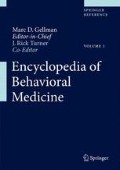Synonyms
Definition
Panic attacks are a state of sympathetic nervous system arousal that results in a discrete episode of intense fear or discomfort in the absence of objective danger. This fear is accompanied by a host of somatic and cognitive symptoms. Symptoms include tachycardia (i.e., racing heart), sweating, palpitations, trembling, dyspnea (i.e., shortness of breath), feelings of being smothered or feelings of choking, nausea, chest pain, abdominal distress, dizziness, light headedness, derealization or depersonalization, numbness or tingling in the face or extremities, chills or hot flushes, fear of “going crazy,” fear of losing control, or fear of death from such an episode. Individuals must report experiencing at least 4 of the 13 possible somatic and cognitive symptoms. These aforementioned symptoms typically peak in intensity over a short period of time (i.e., 10 min or less). If individuals report experiencing excessive fear but manifest fewer than four symptoms, it is considered to be a limited-symptom panic attack. Panic attacks are classified into three main subtypes: cued panic attacks (i.e., panic attacks can occur in response to a specific situation or event), uncued panic attacks (i.e., panic attacks that occur “out of the blue” in the absence of a discernable trigger), or situationally predisposed panic attacks (i.e., panic attacks that occur immediately on exposure to or in anticipation of a specific situational cue or trigger). The experience of at least two uncued panic attacks is a prerequisite for the diagnosis of panic disorder. However, panic attacks can occur in the context of any other anxiety disorder (e.g., generalized anxiety disorder, social anxiety disorder) when cued by situational events or triggers (e.g., in response to excessive worry; during a social interaction). The possible consequences of such episodes make panic attacks of interest to behavioral medicine.
Cross-References
References and Readings
American Psychiatric Association. (2000). Diagnostic and statistical manual for mental disorders (Revised) (4th ed.). Washington, DC: APA.
Antony, M. M., & Swinson, R. P. (2000). Phobic disorder and panic in adults: A guide to assessment and treatment. Washington, DC: American Psychological Association.
McCabe, R. (2001). Panic disorder and agoraphobia: A brief overview and guide to assessment. In M. M. Antony, S. M. Orsillo, & L. Roemer (Eds.), Practitioner’s guide to empirically based measures of anxiety (pp. 87–94). New York: Kluwer Academic/Plenum.
Author information
Authors and Affiliations
Corresponding author
Editor information
Editors and Affiliations
Rights and permissions
Copyright information
© 2013 Springer Science+Business Media, New York
About this entry
Cite this entry
Coons, M.J. (2013). Panic Attack. In: Gellman, M.D., Turner, J.R. (eds) Encyclopedia of Behavioral Medicine. Springer, New York, NY. https://doi.org/10.1007/978-1-4419-1005-9_1162
Download citation
DOI: https://doi.org/10.1007/978-1-4419-1005-9_1162
Publisher Name: Springer, New York, NY
Print ISBN: 978-1-4419-1004-2
Online ISBN: 978-1-4419-1005-9
eBook Packages: MedicineReference Module Medicine

